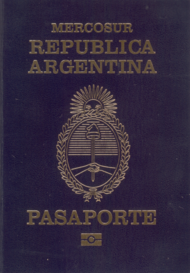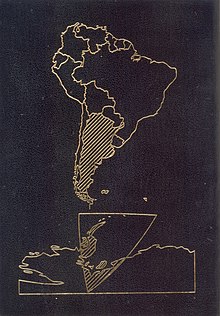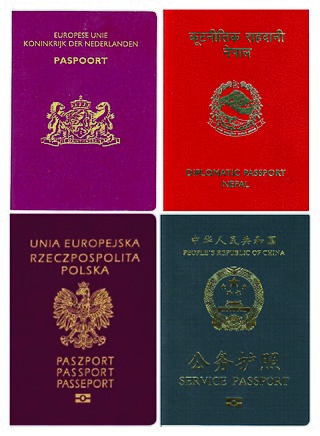
A passport is an official travel document issued by a government that certifies a person's identity and nationality for international travel. A passport allows its bearer to enter and temporarily reside in a foreign country, access local aid and protection, and obtain consular assistance from their government. In addition to facilitating travel, passports are a key mechanism for border security and regulating migration; they may also serve as official identification for various domestic purposes.

An identity document is any document that may be used to prove a person's identity. If issued in a small, standard credit card size form, it is usually called an identity card, or passport card. Some countries issue formal identity documents, as national identification cards that may be compulsory or non-compulsory, while others may require identity verification using regional identification or informal documents. When the identity document incorporates a person's photograph, it may be called photo ID.
The Visa Waiver Program (VWP) is a program of the United States federal government that allows nationals of specific countries to travel to the United States for tourism, business, or while in transit for up to 90 days without having to obtain a visa. It applies to all fifty U.S. states, the District of Columbia, Puerto Rico, and the U.S. Virgin Islands, as well as to Guam and the Northern Mariana Islands, which also have an additional program with waivers for more nationalities; American Samoa has a similar but separate program.
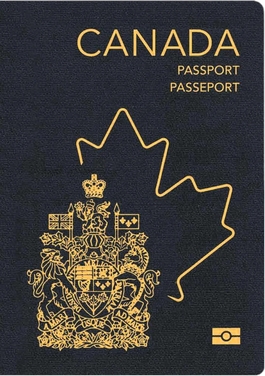
A Canadian passport is the passport issued to citizens of Canada. It enables the bearer to enter or re-enter Canada freely; travel to and from other countries in accordance with visa requirements; facilitates the process of securing assistance from Canadian consular officials abroad, if necessary; and requests protection for the bearer while abroad.

The Israeli passport is the travel document issued to citizens of the State of Israel for the purpose of international travel. It grants the bearer visa-free or visa-on-arrival access to 170 countries and territories, where they are entitled to the protection of Israeli consular officials.

The Singapore passport is a passport issued to citizens of the Republic of Singapore. It enables the bearer to exit and re-enter Singapore freely; travel to and from other countries in accordance with visa requirements; facilitates the process of securing assistance from Singapore consular officials abroad, if necessary; and requests protection for the bearer while abroad.

The Mexican passport is the passport issued to Mexican citizens for the purpose of travelling abroad. The Mexican passport is also an official ID and proof of Mexican citizenship. According to the January 2024 Henley Visa Restrictions Index, holders of a Mexican passport can visit 159 countries without a visa, placing Mexico in the 22nd rank in terms of global travel freedom.

A German passport is an identity document issued to nationals of Germany for the purpose of international travel. A German passport is, besides the German ID card and the German Emergency Travel Document, the only other officially recognised document that German authorities will routinely accept as proof of identity from German citizens. Besides serving as proof of identity and presumption of German nationality, they facilitate the process of securing assistance from German consular officials abroad. German passports are valid for ten years or six years and share the standardised layout and burgundy red design with other EU passports. Every German citizen is also a citizen of the European Union. The passport, along with the national identity card, allows for free rights of movement and residence in any of the states of the European Union, European Economic Area and Switzerland.

A Panamanian passport is the passport issued to citizens of Panama to facilitate international travel. Panamanian citizens enjoy visa-free access to 118 countries and territories. The passports are issued by the Passports Authority of Panama.
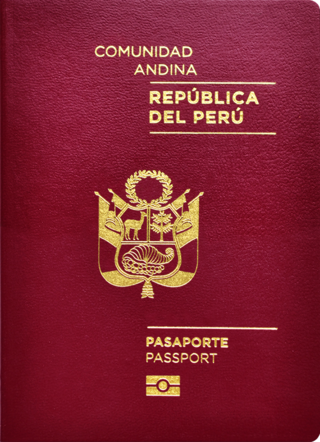
Peruvian passport is a travel document issued to citizens of Peru with the purpose of identification and to travel outside the country. It is issued by the Superintendencia Nacional de Migraciones, the Peruvian immigration and naturalization authority, which is part of the Ministry of the Interior. The Peruvian passport has the benefit of "visa free" status for member nations of the Andean Community and Mercosur, as well as several Central American nations.

The Ukrainian passport is a document issued for nationals of Ukraine as proof of Ukrainian citizenship. The country issues international passports that are used for travel abroad. Until 2016, citizens were issued a soft booklet internal passport as their primary domestic identification document; the booklets were replaced by an identity card with existing passports remaining valid. Electronic passports are available to citizens through the government smartphone application Diia.
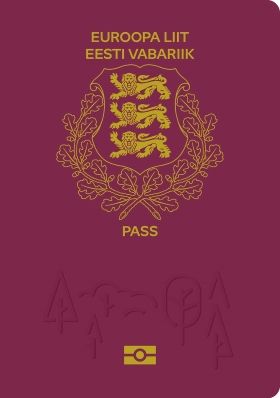
An Estonian passport is an international travel document issued to citizens of Estonia, and may also serve as proof of Estonian citizenship. Besides enabling the bearer to travel internationally and serving as indication of Estonian citizenship, the passport facilitates the process of securing assistance from Estonian consular officials abroad or other European Union member states in case an Estonian consular is absent, if needed. If an Estonian citizen wishes to receive an identity document, especially an Estonian passport, somewhere other than the foreign representation of the Republic of Estonia, then the bearer of the Estonian citizenship staying abroad could receive the travel documents in embassies of any EU country worldwide by paying 50 Euro. Many countries require passport validity of no less than 6 months and one or two blank pages.

Colombian passport is a travel document which is issued to nationals of Colombia for the purpose of international travel. Since September 2015, a biometric passport has been issued, but the previously issued machine-readable passport can be used until its expiration date.
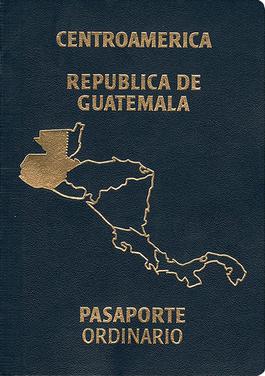
Guatemalan passports are issued to Guatemalan citizens to travel outside Guatemala. As of 1 February 2024, Guatemalan citizens had visa-free or visa on arrival access to 137 countries and territories, ranking the Guatemalan passport 38th in terms of travel freedom according to the Henley visa restrictions index.

A Cuban passport is an identity document issued to citizens of Cuba to facilitate international travel. They are valid for 10 years from the date of issuance, before they used to be valid for 6 years and had to be validated every 2 years.

Brazilian passport is the official document for foreign travel issued by the federal government, through the Federal Police.

Argentine nationality law regulates the manner in which one acquires, or is eligible to acquire, Argentine nationality. Nationality, as used in international law, describes the legal methods by which a person obtains a national identity and formal membership in a nation. Citizenship refers to the relationship between a nation and a national, after membership has been attained. Argentina recognizes a dual system accepting Jus soli and Jus sanguinis for the acquisition of nationality by birth and allows foreign persons to naturalize.

The Canadian Certificate of Identity is an international travel document issued by Immigration, Refugees and Citizenship Canada to a permanent resident of Canada who is not yet a Canadian citizen, is stateless, or is otherwise unable to obtain a national passport or travel document. It is a biometric document with a grey cover and is bilingual in both English and French. The validity period of the travel document is determined by the issuing office.

Documento Nacional de Identidad or DNI, is the main identity document for Argentine citizens, as well as temporary or permanent resident aliens. It is issued at a person's birth, and must be updated at 8 and 14 years of age, and thereafter every 15 years. It takes the form of a card, and is required for voting, payments, military service inscriptions and formalities. They are issued by the National Registry of Persons (RENAPER).
Visitors to Argentina must obtain a visa from one of the Argentine diplomatic missions unless they are citizens of one of the visa-exempt countries.
